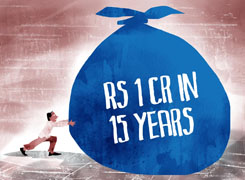Ramalingam Kalirajan |10872 Answers |Ask -Follow
Mutual Funds, Financial Planning Expert - Answered on May 21, 2024
He has an MBA in finance from the University of Madras and is a certified financial planner.
He is the director and chief financial planner at Holistic Investment, a Chennai-based firm that offers financial planning and wealth management advice.... more

How to achieve 1 crore in 4 year
You have a goal to accumulate ?1 crore in 4 years. This is an ambitious target but achievable with a strategic approach.
Understanding Your Current Financial Situation
First, evaluate your current financial status. Assess your savings, existing investments, and monthly income. Knowing where you stand helps plan your path forward.
Developing a Strategic Investment Plan
A clear investment strategy is essential. Focus on high-growth investment options. Actively managed funds are recommended over index funds. Fund managers can make dynamic decisions to maximize returns.
Benefits of Actively Managed Funds
Actively managed funds have the potential to outperform the market. Skilled fund managers make informed decisions based on market trends. This can lead to higher returns compared to index funds, which simply track market performance.
Monthly Investment Commitment
Determine a monthly investment amount that aligns with your goal. Consistent investments through Systematic Investment Plans (SIPs) can build significant wealth over time. Calculate the required SIP amount to reach ?1 crore in 4 years.
Diversifying Your Portfolio
Diversification reduces risk and improves returns. A balanced mix of equity and debt funds is crucial. Equity funds offer higher growth potential, while debt funds provide stability and lower risk.
Monitoring and Adjusting Investments
Regularly review and adjust your investment portfolio. Market conditions and personal circumstances can change. Annual reviews with a Certified Financial Planner ensure your investments stay on track towards your goal.
Risk Management and Adaptability
Understand your risk tolerance and adjust your investments accordingly. As you get closer to your goal, consider shifting to lower-risk investments. This strategy protects your accumulated wealth from market volatility.
Professional Guidance
Seek advice from a Certified Financial Planner. Their expertise provides tailored investment strategies. They help optimize your portfolio to achieve your financial goals efficiently.
Staying Disciplined and Committed
Consistency is key to achieving your target. Stay disciplined with your monthly investments. Avoid withdrawing funds prematurely and stick to your investment plan.
Inflation Considerations
Inflation can erode the value of money over time. Ensure your investments grow at a rate that outpaces inflation. This ensures your ?1 crore target retains its purchasing power.
Emergency Fund and Insurance
Maintain an emergency fund separate from your investment portfolio. This fund covers unexpected expenses and ensures you don’t disrupt your investment plan. Adequate insurance, especially health insurance, protects against unforeseen medical costs.
Appreciating Your Progress
Your dedication to achieving ?1 crore in 4 years is commendable. Setting such an ambitious goal shows your commitment to financial security. Continue your efforts with confidence and regular guidance from a Certified Financial Planner.
Conclusion
Reaching ?1 crore in 4 years requires a strategic approach. Focus on high-growth investments, maintain regular reviews, and stay disciplined. With professional guidance and commitment, you can achieve your financial target.
Best Regards,
K. Ramalingam, MBA, CFP,
Chief Financial Planner,
www.holisticinvestment.in
You may like to see similar questions and answers below
Ulhas Joshi |280 Answers |Ask -Follow
Mutual Fund Expert - Answered on Mar 15, 2023
Ramalingam Kalirajan |10872 Answers |Ask -Follow
Mutual Funds, Financial Planning Expert - Answered on May 08, 2024
Ramalingam Kalirajan |10872 Answers |Ask -Follow
Mutual Funds, Financial Planning Expert - Answered on Jul 17, 2024
Ramalingam Kalirajan |10872 Answers |Ask -Follow
Mutual Funds, Financial Planning Expert - Answered on Nov 25, 2024
Nitin Narkhede | Answer |Ask -Follow
MF, PF Expert - Answered on Jan 23, 2025
Radheshyam Zanwar |6735 Answers |Ask -Follow
MHT-CET, IIT-JEE, NEET-UG Expert - Answered on Dec 06, 2025
Dr Nagarajan J S K |2576 Answers |Ask -Follow
NEET, Medical, Pharmacy Careers - Answered on Dec 06, 2025
Mihir Tanna |1090 Answers |Ask -Follow
Tax Expert - Answered on Dec 06, 2025
Ramalingam Kalirajan |10872 Answers |Ask -Follow
Mutual Funds, Financial Planning Expert - Answered on Dec 06, 2025
Radheshyam Zanwar |6735 Answers |Ask -Follow
MHT-CET, IIT-JEE, NEET-UG Expert - Answered on Dec 06, 2025
Radheshyam Zanwar |6735 Answers |Ask -Follow
MHT-CET, IIT-JEE, NEET-UG Expert - Answered on Dec 06, 2025
Radheshyam Zanwar |6735 Answers |Ask -Follow
MHT-CET, IIT-JEE, NEET-UG Expert - Answered on Dec 06, 2025
Dr Dipankar Dutta |1837 Answers |Ask -Follow
Tech Careers and Skill Development Expert - Answered on Dec 05, 2025
Dr Shyam Jamalabad |108 Answers |Ask -Follow
Dentist - Answered on Dec 05, 2025
Dr Shyam Jamalabad |108 Answers |Ask -Follow
Dentist - Answered on Dec 05, 2025




























